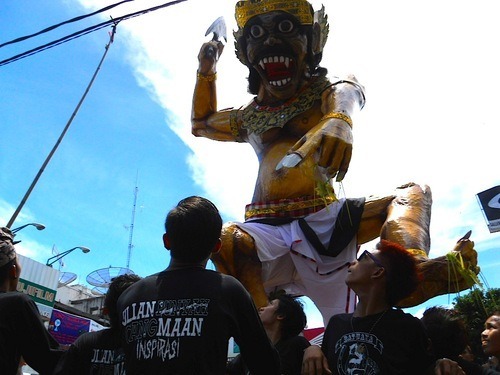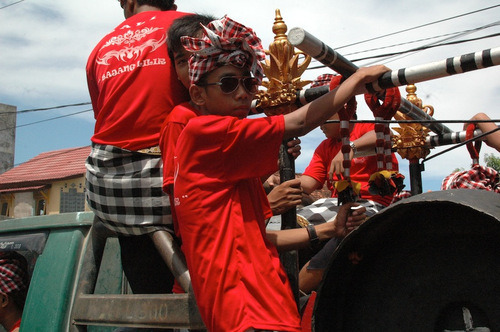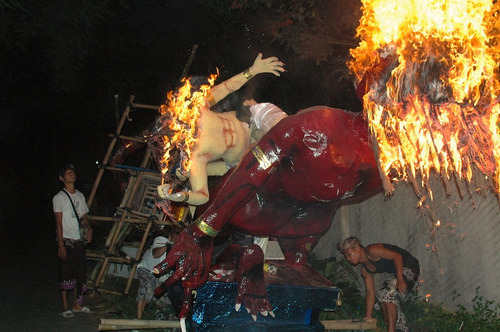
Suranadi, West Lombok—Wind rustles the palm fronds lining the paddy field below. Across the valley, a rooster tentatively crows. Even for village Indonesia, the scene is oddly quiet. Not a bad spot for some enforced reflection.
And that is exactly what I’m in for, this Nyepi – the so-called ‘Day of Silence,’ the first day of the Saka calendar that determines the yearly Balinese ritual cycle. No cooking is allowed. No electricity is used. Everyone in Suranadi, including me, must stay at home. Religious policemen patrol the lanes to fine violators.
That’s okay with me. After living a year in chatty, clangorous Indonesia, I don’t mind this rare, calm day filled with nothing but sunshine and birdsong. As a young reporter launching a career in a new country and about to be married, of course I have anxieties to reflect upon.
Then too, this silence is all the more welcome after the day I spent yesterday: following giant, day-glow parade floats, amidst crushing crowds, in sunstroke-inducing heat to the din of gongs and cymbals. The float imagery is all fangs and claws and disemboweled guts, vaguely drawn from traditional Hindu iconography, with a sprinkling of more contemporary social commentary – an enormous diapered baby to represent over-population, a rat in a necktie to depict corrupt officialdom.



These demons, or Ogoh-ogohs, are not real monsters but rather reminders of the many distractions that keep us from self-reflection, explained one local Brahmin priest, Ide Bagus. And in that way, the Ogoh-ogoh parade and silence of Nyepi are paired like Halloween and All Saints’ Day—a purge of evil followed by a day of holiness.
None of this looks much like the Hinduism I saw growing up in South India which was chaste and vegetarian. But what would you expect from a country that considers Hindu cuisine to be pork sate.
Some Balinese themselves are bothered by this disjunction. At the edge of the parade route, a group of Hare Krishna devotees huddled around an altar where three tonsured Brahmins wafted incense with a peacock feather fan. Down the road, a thirty-year-old Hindu evangelist sold copies of the Bhagvad Gita. “Balinese Hindus today have lost their way,” he said. “They get drunk, they gamble, they eat meat and eggs.” An ex-cock-fighter, he mended his ways to bring himself “closer to the original text of the Vedas.”
But by-the-book Hinduism doesn’t get much traction in Indonesia. In fact, over the last twenty years, the eclecticism and gaudiness of the Ogoh-ogoh tradition has only gotten more lavish. This trend is unlikely to fade either as the artistes behind the effigies come from banjars or neighborhood Hindu youth groups.
As Brahmin Bagus put it, “art is for young people to make and old people to support;” making the month-long process of ogoh-ogoh building a religiously sanctioned riff on the meaning of evil and distraction. And the arts and craft exercise instills a good dose of religious pride, if not co-opting of Hinduism by the young.



On the day of parade, the uninitiated might mistake the event as a multi-kilometer mosh pit. Teenagers decked with heavy eye-liner and bleached blonde hair sport shirts that proclaim them ‘Hindu.’ In bold Helvetica, other shirts beg ‘God Please Blessing Me.’ Pre-teen gamelan players use soda straws to exaggerate their spiked hairdos, head banging as they clang cymbals and gongs. Even the closing burn of effigies is left to just neighborhood youth. At dusk, mothers in more traditional sarongs head home. The young are left to stare on alone as their Styrofoam creations evaporate into the plumes of fire.

Yet there is something truly edifying about the practice of making and purging the world of Ogoh-ogohs, as I learned when I sketched out my own personal demon to burn. The process of linking multiple issues together into one problematic creature to depict gave me a lot of clarity. It also offered the rare adult moment to draw. Burning the painting under the dark, star-lit night sky was a rapid tutorial in detachment.
This morning, I woke with more confidence and clarity about the world.
By afternoon, the religious police relaxed their monitoring. Kids ventured into the empty paddy field to fly kites in the frond-rustling wind. Mothers carried bundles of laundry to the temple spring. They are ready for the New Year to begin.
This piece was written March 12th. The Mataram Ogoh-ogoh parade was March 11th. My parents and I are traveling through the east Indonesia island of Lombok. These are updates from our trip in no particular order.
stan-photos liked this
 tadipagi posted this
tadipagi posted this